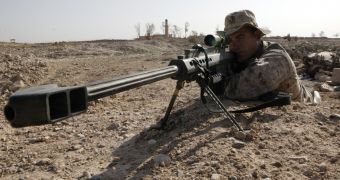The word "sniper" is understood by most people whi are not military experts as being a lone gunman, who goes undetectable, on the hunt. Army snipers are indeed the best shooters in the world, who hide, line up a target in their sights and pull the trigger, but there actually is a lot more about them that you probably didn't know.
A sniper is a highly trained soldier who specializes in shooting targets with modified rifles from incredibly long distances. They're also adept in stealth, camouflage, infiltration, and observation techniques.
These marksmen are really highly skilled, that's why they are often seen as lone assassins that rack "confirmed kills." In reality, true snipers work for the military and law enforcement agencies and are far more concerned with the number of lives they save than with the ones they take.
Many variables have to be taken into consideration by the sniper, before he actually squeezes the trigger. Elements like wind speed, wind direction, atmospheric pressure, target movement, mirage, light source, range, temperature, and that's just the beginning. The work that goes into getting a good position to take a shot is tremendous. That's why all snipers in the service of armies around the worlld work in pairs. Most people are really surprised to hear that.
A sniper team consists of a sniper and a spotter. The two-man team offers many advantages over the deployment of a lone sniper in the field. The spotter carries his own special scope that is much more powerful than the scope on a sniper rifle. The spotter uses his scope to help the sniper observe objectives and set up the shot. The two soldiers work together to get to the objective safely and discreetly and then set up a position.
Actually, most sniper missions end without a single shot being taken.
Reconnaissance is actually the main role of the sniper on the battlefield, and because they are are stealth warriors, they are perfectly equipped to sneak behind enemy lines, thus providing command with information about the enemy's size, strength and location. Snipers are also utilized in support roles. These support roles can be an over-watch position or a blocking action. When a sniper is in an over-watch position, he sets himself up in a concealed place that gives him a clear view of the battlefield.
There he can support the assault force by taking out enemy forces that are endangering the advancing platoon. In a blocking action, snipers set up to help secure a position that is controlled by their platoon. They may set up on a roof and help ground forces defend their position.
Snipers teams often have to stay completely still for hours or days at a time to avoid detection, waiting for the right moment to take the shot.
But when they do take a shot, they do it with surgical precision and maximum efficiency: an officer taking a break to smoke a cigarette, a pilot flight-checking his helicopter, an armed guard on patrol, but most of all, an "inconvenient" leader, these are usually the key targets of a sniper.
"One shot, one kill" is the sniper motto, and this can only be accomplished with the help of heavily modified rifles, with hollow wood or fiberglass handles, upgraded trigger mechanisms and high-power optical telescopes.
Some fine examples would be the SVD Dragunov, the M21 Sniping Rifle, up to the .50 caliber, 57 inches(122cm), 31 lbs (14 kg)) 82A1/M107 Barrett, the mother of all snipers.
All this being said, I'm sure nobody would like to be on the wrong side of the scope. But for those who, by accident, will, here's a good news: you'll never see, or hear it coming.

 14 DAY TRIAL //
14 DAY TRIAL //